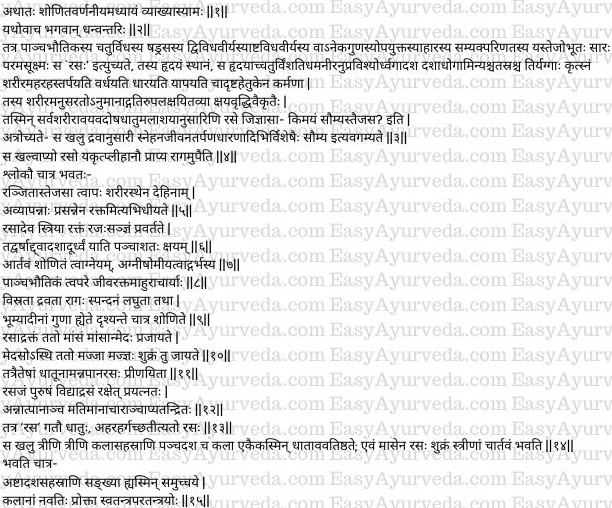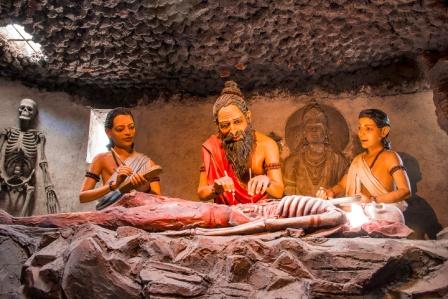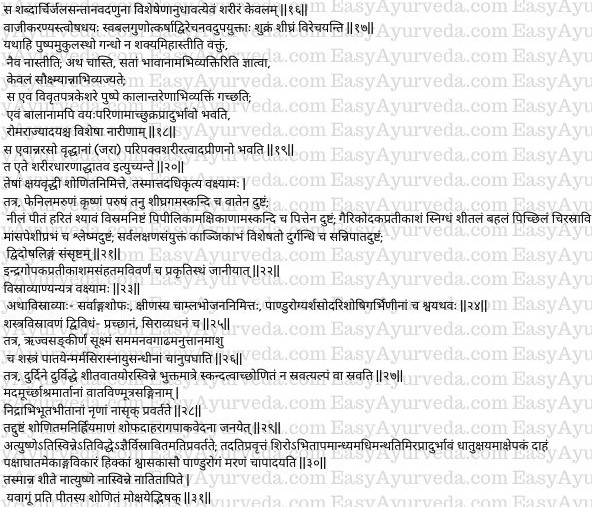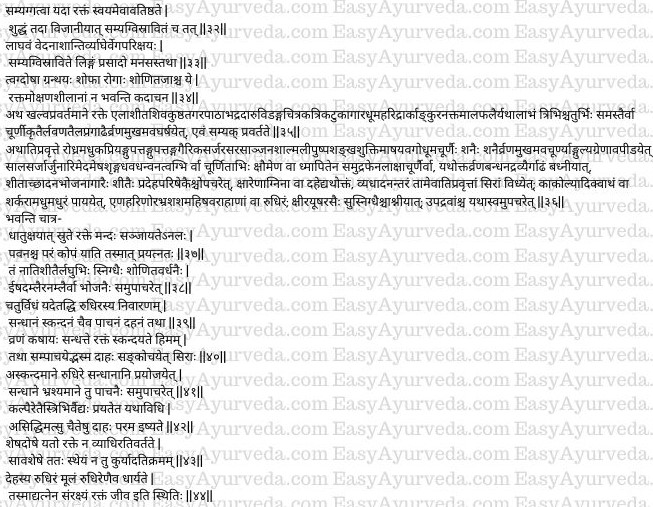Sushruta Samhita Chapter 14 Shonitavarnaniya Adhyaya

This article explains Sushruta Samhita Sutrasthana Chapter 14 “Shonitavarnaniya Adhyaya”- Description of blood.

Table of Contents
Shonitavarnaniya Adhyaya
Description of blood
We will now expound the chapter called Shonita Varnaniya- description of blood; as revealed by the venerable Dhanvantari.
Read – Understanding Blood Functions, Vitiation And Treatment As Per Ayurveda
Rasa – Rakta utpatti – Production of blood
When the food (that we consume) which is composed of pancabhutas (five basic elements of nature – prithvi – earth, ap – water, teja – fire, vayu – wind and akasa – ether), is of four types (peya – drinkables, lehya – lickables, bhojya – chewable and bhaksya – eatables), having six tastes (madhura – sweet, amla – sour, lavana – salt, katu – pungent, tikta – bitter and kasaya – astringent), of two potencies (usna – hot and sita – cold) or eight potencies (usna – hot, sita – cold, snigdha – unctuous, ruksa – dry, guru – heavy, laghu – light, mrdu – soft and tiksna – sharp) and possessing many properties, consumed in proper way, gets digested properly (and completely) by the action of digestive fire – the vital essence of such food is formed. This essence is known as ‘Rasa’. (This rasa is very subtle – thin and suitable to move through even the minute channels in the body). Hrdaya – heart is the seat of this rasa. This rasa, from the heart, travels through twenty-four dhamanis (arteries) – ten of them going upwards, ten going downwards and four going side-wards / obliquely – nourishes the entire body constantly, causes growth of the body, supports and maintains it. The adrshta (invisible causes) i.e., the effect of the deeds done in the past life is also responsible for these events to occur. The status of rasa which is constantly travelling (circulating) in the body can be inferred by its increase, decrease or the abnormalities it produces.
This ‘rasa’ is constantly moving in the entire body, in its different parts, organs, doshas, dhatus (tissues), malas (excreta) and viscera. There is a debate related to this rasa so as to whether rasa is soumya (cold in properties and action) or taijasa (hot in properties and actions). The reply is – since rasa is a liquid possessing properties such as unctuousness, enliving (sustaining life), nourishing, supporting etc, it shall be considered to be soumya only i.e., cold in properties and actions.
Read – Rasa Dhatu: Definition, Formation, Circulation, Imbalance Diseases, Treatment
Formation of rakta – blood from rasa tissue
The rasa which is apya i.e., predominantly made up of water (possesses properties and actions similar to that of water) on reaching yakrit (liver) and pliha (spleen) attains red colour (and becomes blood tissue).
Definition (formation) of rakta – blood tissue
This Apya Rasa i.e., rasa having appearance, properties and action similar to that of water (water- like rasa) after getting red colour by the action of Tejas (heat, fire-like agency – ranjaka pitta located in the liver and spleen in this context, since pitta is a representative of fire in the body) present in the body (in the liver and spleen) remaining un-vitiated and clear, comes to be called as Rakta (blood).
Read – Signs Of Person Having Enriched Blood (Rakta Sara Purusha Lakshanas)
Formation of Rajas – menstrual blood
From the Rasadhatu itself is produced the blood in women and is called as Rajas (menstrual blood). This blood named rajas starts flowing after the age of twelve years and diminishes (stops) by fifty years of age.
Though these rajas, which is also known as artava is formed from the rasa itself, it is agneya (fiery – possesses the properties of fire) in nature (unlike rasa which is watery in nature). It will not have the watery nature of rasa because the garbha (embryo / foetus) has the qualities of both fire and water.
Read – Artava – Menstrual Blood Formation, Healthy Characteristic Features
Jivarakta
Other authors opine that the jivarakta (blood which is in the form of life or the blood which supports all life activities) is formed by mahabhutas (all five elements of nature – earth, water, fire, wind / air and ether).
Qualities of Mahabhutas in Blood
Bad smell, liquidity, red colour, throbbing and levity are the qualities of prithvi (earth) and other bhutas (elements of nature) respectively. They are also found in the blood (since blood is made up of pancha mahabhutas).
Note –
Visrata – bad smell of the blood is the quality of prthvi (earth element). Dravata – liquidity of the blood is the quality of ap / jala (water element)
Raga – red color of the blood is the quality of teja / agni (fire element)
Spandana – throbbing in the blood is the quality of vayu (air element)
Laghuta – lightness of the blood is the quality of akasa (ether element)
Dhatuutpatti – Genesis of other tissues (chronology of formation of tissues)
From rasa dhatu – rakta dhatu (blood) gets formed.
Then, from the rakta, the mamsa (muscle tissue) is formed.
From mamsa (muscle tissue), medas (fat or adipose tissue) is formed.
From Medas (fat tissue), asthi dhatu (bone tissue) is formed.
From asthi (bone), majja (bone marrow) tissue is formed.
Finally, from majja (bone marrow), shukra (semen, reproductive tissue) is formed.
Rasa nourishes all tissues
Rasa – the essence of foods and drinks is the supplier of nutrients for all these dhatus (tissues).
Man is the product of rasa
Man is born from rasa (essence of food). Hence this rasa should be protected (prevented from vitiation or loss) by all efforts. Therefore, a wise person should carefully (without any lassitude) exercise care in consuming foods and drinks and other activities.
Read – Dhatu – 7 Body Tissues As Explained In Ayurveda
Rasa Nirukti
Definition of Rasa
The term ”Rasa” is derived from the verbal root ‘Ras’ meaning’ movement’ since it is moving constantly it is called rasa.
Dhatu Parinama Kala- time for formation of tissues
This rasa remains in each Dhatu (tissues) for a period of three thousand and fifteen Kala. In this manner rasa becomes sukra (semen, sperms) in men and artava (menstrual blood, ovum) in women in the course of one month.
Taken this way, according to this (Sushruta Samhita) and also other treatises, the number of kalas required (for the transformation of rasa into sukra) will be eighteen thousand and ninety.
Rasagati
Nature of movement of rasa
This rasa dhathu circulates throughout the body in subtle ways like the continuity of sound (sideways), flame (upwards) and water (downwards).
Notes:- Dalhana explains this simili interpreting the continuity of sound as sideward movement, that of flame as upward movement and that of water as downward movement.
Action of Vajikarana medicines (aphrodisiacs) Aphrodisiac medicines when used, causes quick purgation of (elimination) of Sukra (semen), just like a virechana aushadi i.e., purgative drug, by the virtue of their increased strength (power), qualities or both.
Notes:- The term purgation as referred to semen, includes both its production and elimination. The implication of the above statement is that the production of Sukra – the last Dhatu (semen), can also take place quickly even without undergoing the usual course of formation of Dhatus one after the other successively (i.e., in contrary to one month required for the formation of shukra from rasa as explained above).
The smell can neither be said as ‘present’ nor as ‘absent’ in the context of a flower bud. It is present (deficiently, in a latent form) in view of the dictum (that thing / qualities) ‘that which exists must manifest’. The smell due to their minuteness will not manifest (not be recognized) in the bud stage of the flower. The same smell would in due course of time become well manifest when the bud develops into flower and opens its petals and filaments. Similarly in children, though the shukra (semen) is present (in a latent and unexpressed way, just like the smell of the bud), its manifestation i.e., production and elimination (ejaculation) occur only after the change of age in them i.e., when the children mature into adults. This condition i.e., adolescence is also marked by the appearance of romaraji etc i.e., appearance of beard, moustache, hairs around the genitals etc. In women (girls) along with the appearance of pubic hairs, the menstrual blood gradually accumulates (in the uterus) leading to growth (development) of breasts, uterus and vagina.
The same annarasa i.e., essence of food will not be able to satisfy the nutrition and nourishment of the old aged people since their body (tissues) are over-matured due to senility.
Read – Charaka Chikitsa 2.1 Samyoga Sharamuliya Vajikarana Pada
Dhatu nirukti
Definition of Dhatu
Since they support (maintain) the body, these (rasa, rakta, mamsa, meda, asthi, majja, shukra) are called dhatus (tissues).
Relationship of increase and decrease of dhatus with shonita (blood)
The decrease and increase of these tissues are caused by blood. Therefore, we shall elaborate on that (blood) now.
Features of ‘blood vitiated by vata’ – The blood vitiated by vata is frothy, slightly reddish or black, non-slimy, thin, quick flowing and non-clotting in nature.
Features of ‘blood vitiated by pitta’ – The blood vitiated by pitta is blue, yellow, green or black in colour. It will have an unpleasant smell, not liked by ants and flies and non-clotting in nature.
Features of ‘blood vitiated by kapha’ – The blood vitiated by kapha would have the colour similar to the solution of gairika (red ochre), is unctuous, cold, thick, slimy, flowing slowly and resembles the muscles.
Features of ‘blood vitiated by all the three doshas’ – The blood vitiated by all the three doshas will have all the features (mentioned in blood vitiated by individual doshas), resembles kanjika (rice gruel) and has a very bad smell especially.
Features of ‘blood vitiated by two doshas’ – The blood vitiated by combination of two doshas will have features of any two doshas in the blood.
Read – Raktavaha Srotas: Description, Vitiation Symptoms, Treatment
Suddha Rakta
Pure Blood
The blood should be considered to be normal when it –
- resembles indragopa (cochineal) insect
- is bright red in color
- is not thick
- is not discoloured
Rakta Moksana arha, Anarha
Persons fit and unfit for blood lettings
Persons fit for blood will be described elsewhere (chap. 8 of Sarira Sthana). Persons unfit for bloodletting are –
- those who have swelling all over the body,
- those who are emaciated due to intake of sour foods(for a long time),
- those who are suffering from diseases such as anaemia, haemorrhoids, abdominal enlargement, consumption
- pregnant women and
- those who are suffering from dropsy
Read – Raktamokshana Benefits, Types, Procedure, Indications
Rakta Moksana vidhi
Procedure of bloodletting
Rakta Visravna (letting out blood using a sharp instrument) is of two kinds,
1. Pracchana – scratching and
2. Siravyadhana – vein puncturing / venesection
1. Pracchana- scratching/lacerating the skin
Scratching or lacerating the skin should be done in a straight line, those lines should not be joined together, fine, even, not too deep and not very superficial. The procedure (scratching) should be done by using the instrument very quickly without damaging the vital spots, veins (blood vessels), ligaments and joints.
2. Sira Vyadha-Puncturing the vein
The blood would become thick and does not flow out as much as it is required to flow or flows in lesser quantity if sira vyadha is done in the below mentioned conditions –
- if done on a cloudy day
- if the puncture is done in an improper way,
- if one gets affected with cold and breeze
- if sudation has not been done earlier to vein puncture / venesection
- if it is done after the meals
The blood does not flow out after bloodletting procedure has been done in people suffering from the below mentioned conditions –
- intoxication
- fainting
- exertion
- who have (used to) suppressed the urges of flatus, faeces and urine
- those in grip of sleep,
- those who are scared (in fear)
Read – Siravyadha Method Of Bloodletting: Procedure, Precautions, Benefits
Asravya Dosha
Effect of absence or inadequate flow
If the vitiated blood is not let out (in sufficient quantity) it gives rise to swelling, burning sensation, redness, ulceration and pain.
Atisravya Dosha
Effects of excess flow
Excessive blood flow following vein puncture (bloodletting) occurs –
- if it is done during the time of great heat i.e., summer
- if done in those who have been given with excessive sudation,
- if excessive or too deep cut / puncture has been done,
- if done by an ignorant (unskilled, inexperienced) person (physician, surgeon),
When blood flows out in excess it would produce –
- headache
- blindness
- glaucoma
- depletion of tissues
- convulsions
- burning sensation
- hemiplegia
- monoplegia
- hiccup
- dyspnoea
- cough
- anemia
- death
Ideal conditions to conduct bloodletting
Hence bloodletting should be done by the physician,
- on the day which is neither very cold nor very hot
- neither without sudation nor having done sudation in excess and
- the patient having consumed Yavagu (thin gruel)
Notes:- According to Dalhana, Yavagu that is prepared from tila (sesame) is best suited here since it is a quick lubricant and quickly excites the blood. This should be consumed many times.
How to identify that the blood has been drained properly?
The blood which stops all by itself after adequate flow should be considered as pure (not vitiated) and as properly drained.
Samyak Visravana
Signs of proper blood flow
Below mentioned are the symptoms of proper blood flow (following bloodletting) –
- feeling of lightness of the body
- pacification of pain / disease (mitigation of suffering)
- subsiding of severity (bouts) of the disease
- cheerfulness / pleasantness of the mind
Benefits of Bloodletting
Diseases of the skin, tumours, oedema and diseases arising from blood will never occur in persons indulging in bloodletting (whenever required).
Read – Blood Letting Therapy – Siravyadha – Astanga Hrudaya Sutrasthana 27
Srava Pravartana
Increasing the flow if there is inadequate flow
If the blood does not flow out (due to any reason) then, Ela, Sitasiva, Kustha, Tagara, Patha, Bhadradaru, Vidanga, Citraka, Trikatu, Agaradhuma, Haridra, Arkankura (leaf buds of Arka), Naktamala, Phala either three, four or all of them (as many as available) should be powdered, mixed with more quantity of salt and oil, should be rubbed on the mouth of the wound; by this, the blood flows out properly.
Atisrava Nirodha
Controlling heavy bleeding
When the blood flows greatly – Rodhra, Madhuka, Priyangu, Patanga, Gairika, Sarjarasa, Rasanjana, Salmalipuspa, Sankha, Sukthi,Masa, Yava and Godhuma should be made into powder and this powder shall be sprinkled on the wound and pressed into the wound with the tip of the fingers. Or powder of bark of Sala, Sarja, Arjuna, Arimeda, Mesasrngi, Dhava and Dhanvana; or Ash of Ksauma (flax) or powder of Samudraphena and Laksa may be sprinkled.
Then a bandage may be tied tightly using any suitable bandaging material.
Later, the site should be covered with cold things (like leaf of lotus, wet cloth etc). The patient should be given cold foods, made to live in a cold room, applied with cold medicinal pastes (poultices) prepared from drugs having cold potency, and the site shall be sprinkled / bathed or poured with cold liquids (decoctions prepared with drugs having cold potency).
Read – Veerya, Potency Of Herbs And Doshas – Inter-relationship
If the bleeding does not stop in spite of all these measures, the site (veins in that site) should be burnt (cauterized) with caustic alkali or fire.
If after the puncture of a vein if the bleeding does not stop, the same vein shall be cut (punctured) once again at another site.
The decoction prepared from the drugs belonging to the Kakolyadi Gana group of herbs (vide. Chapter 38) should be given to drink after having added and sweetened with sugar and honey.
Alternatively, the blood of the deer, antelope, camel, rabbit, buffalo or boar may be given to drink.
Or the person (patient) may be made to drink the blood of deer, antelope, camel, rabbit, buffalo or boar.
Or he may take an unctuous meal (added with more of ghee or oil) along with milk, soup of grains or meat.
If any complications have appeared, they shall be treated accordingly (as suggested in the classics).
Dietetic protocol in excessive bleeding
Excessive bleeding leads to depletion of other tissues in the body. This in turn leads to depletion of digestive fire and severe aggravation of vata. Hence the patient should be treated with foods (and things) which are –
- not very cold
- light (easily digestible)
- unctuous
- promote blood formation and
- either slightly sour or devoid of sour
Read – Sour Taste – Qualities, Health Benefits, Side Effects
Raktasrava Nirodha Krama
Methods of preventing bleeding
There are four types of methods to prevent excessive bleeding. They are –
- Sandhana – joining the edges of the wound
- Skandana – promoting the process of clotting
- Pacana – cooking (ama etc associated with blood)
- Dahana – cauterization / burning using alkali or fire
Kashaya – astringent drugs / decoctions are useful for sandhana – unification of the edges of the wound.
Hima – cold things help/ promote in skandana i.e., clotting of blood.
Bhasma – ash or alkali helps in pacana i.e., cooking of wounds.
Daha – burning by fire (thermal cauterization) helps in dahana i.e., cauterization by causing constriction of the veins.
Sequence of treatments to check excessive bleeding
If the blood does not clot, then sandhana should be considered i.e., methods of promoting union (joining of the edges of the wound).
If sandhana i.e., joining the edges of the wound fails, then it shall be treated with pacana (with digestives).
Initially the physician should put all efforts and try to stop bleeding by these three methods only (sandhana, skandana and pacana).
If these measures do not succeed, then burning with fire (thermal cauterization) is the best method to check the bleeding.
Read – Bleeding Disorders: Ayurveda Treatment, Diet, Home Remedies
Excessive bloodletting should not be done
Diseases do not get aggravated even when a little quantity of vitiated blood remains in the body (little quantity of vitiated doshas remain in the blood), hence bleeding should be stopped allowing a balance to remain. On the other hand, too much treatment (causing excessive bleeding) should not be undertaken (since it is harmful).
Blood is the root cause for the existence of the body
Blood is the root (cause) of the body. The body is supported and maintained by the blood itself. Therefore, the blood should be protected with all efforts since blood itself it (the indicator) of life.
Sanskrit Verses




Balancing Vata after bleeding
After bleeding, Vata gets aggravated by bathing (showering, streaming) the area (from where bleeding has occurred) with cold liquids etc (which are methods of controlling the bleeding). This aggravated vata gives rise to swelling along with pricking (throbbing) pain. This should be treated by bathing the area (from where bleeding has occurred) with lukewarm ghee.
Thus ends the Fourteenth chapter Shonitavarnaiya by name in Sutra Sthana of Susruta Samhita.









